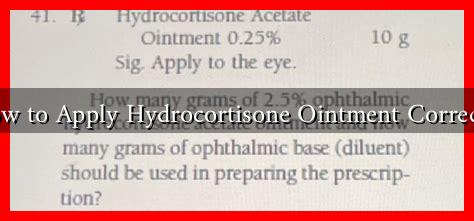-
Table of Contents
- How to Apply Hydrocortisone Ointment Correctly
- Understanding Hydrocortisone Ointment
- When to Use Hydrocortisone Ointment
- Steps for Correct Application
- 1. Clean the Affected Area
- 2. Apply a Thin Layer
- 3. Rub It In Gently
- 4. Wash Your Hands
- 5. Follow Dosage Instructions
- Precautions and Side Effects
- Case Studies and Statistics
- Conclusion
How to Apply Hydrocortisone Ointment Correctly
Hydrocortisone ointment is a topical corticosteroid used to relieve inflammation and itching caused by various skin conditions, such as eczema, dermatitis, and insect bites. While it can be highly effective, proper application is crucial to maximize its benefits and minimize potential side effects. This article will guide you through the correct application of hydrocortisone ointment, ensuring you achieve the best results.
Understanding Hydrocortisone Ointment
Hydrocortisone is a synthetic form of cortisol, a hormone produced by the adrenal glands. It works by suppressing the immune response and reducing inflammation. Hydrocortisone ointments are available in various strengths, typically ranging from 0.5% to 2.5%. The higher the concentration, the more potent the effects, but also the greater the risk of side effects.
When to Use Hydrocortisone Ointment
Hydrocortisone ointment is commonly used for:
- Eczema
- Psoriasis
- Contact dermatitis
- Insect bites
- Rashes
Before using hydrocortisone, it is essential to consult a healthcare professional, especially for children or if you have underlying health conditions. They can provide guidance on whether hydrocortisone is appropriate for your specific situation.
Steps for Correct Application
Applying hydrocortisone ointment correctly can enhance its effectiveness and reduce the risk of side effects. Follow these steps:
1. Clean the Affected Area
Before applying the ointment, wash the affected area gently with soap and water. Pat it dry with a clean towel. This step removes dirt and oils, allowing the ointment to penetrate the skin better.
2. Apply a Thin Layer
Using clean fingers or a cotton swab, apply a thin layer of hydrocortisone ointment directly to the affected area. Avoid using excessive amounts, as this can lead to skin thinning and other side effects.
3. Rub It In Gently
Gently massage the ointment into the skin until it is absorbed. This helps ensure even distribution and enhances absorption.
4. Wash Your Hands
After application, wash your hands thoroughly to avoid spreading the ointment to other areas of your body or to other people.
5. Follow Dosage Instructions
Adhere to the dosage instructions provided by your healthcare provider or the product label. Typically, hydrocortisone ointment is applied 1-2 times daily, but this may vary based on the condition being treated.
Precautions and Side Effects
While hydrocortisone ointment is generally safe for short-term use, it is essential to be aware of potential side effects, including:
- Skin thinning
- Stretch marks
- Burning or itching at the application site
- Increased risk of skin infections
To minimize these risks:
- Use the ointment only as directed.
- Avoid using it on large areas of skin or for extended periods.
- Do not apply it to broken or infected skin.
Case Studies and Statistics
According to a study published in the Journal of Dermatological Treatment, improper use of topical corticosteroids can lead to significant side effects, including skin atrophy in 30% of patients. This highlights the importance of following proper application techniques and guidelines.
Conclusion
Hydrocortisone ointment can be an effective treatment for various skin conditions when applied correctly. By following the steps outlined in this article, you can maximize its benefits while minimizing potential side effects. Always consult with a healthcare professional before starting any new treatment, and remember that proper application is key to achieving the best results. With the right approach, hydrocortisone ointment can help you regain healthy, comfortable skin.


